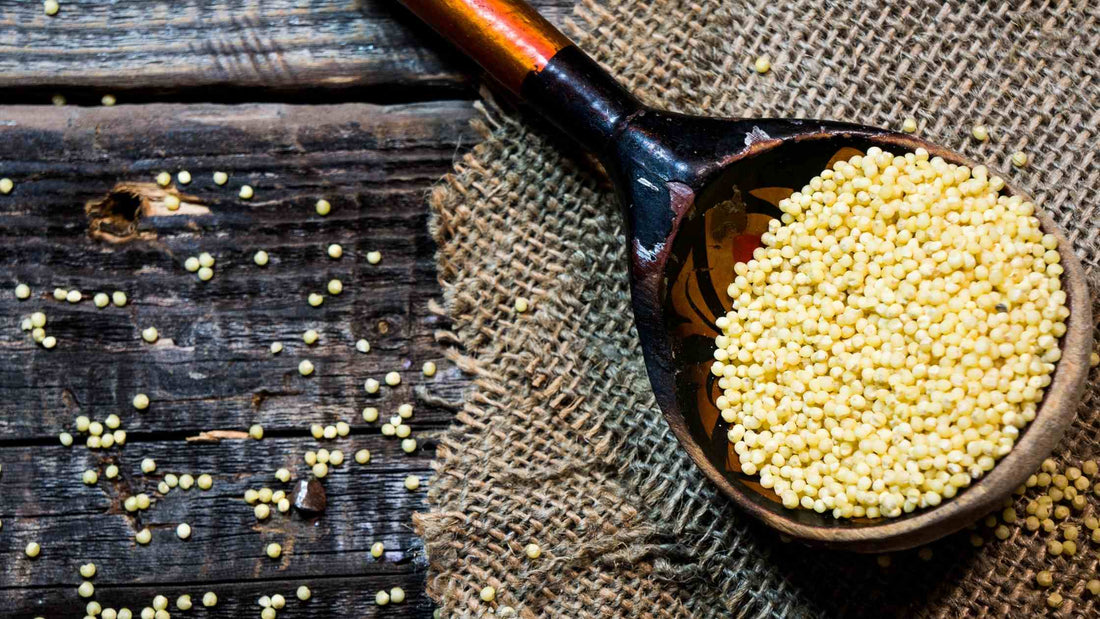
How to Use Millets for Weight Loss?
Naturally YoursShare

Millet Pulav anyone?
A few years ago, people would have likely answered this with a question on their own- what is a millet?
Not anymore! Yes, millets in India enjoy prime importance now since India is one of the largest producers clocking 11 million tonnes every year.
Like other countries, we Indians too have the riches of our food for good health. One such secret of good health is a variety of millets available in India.
What are millets?
Millets are a group of small seed grasses grown in semi dry areas in Asia as well as Africa. They are widely cultivated as cereal crops or as fodder for animals.
Types of millets
- Sorghum (Jowar)
- Pearl Millet (Bajra)
- Finger Millet (Ragi/Nachni)
- Little Millet (Vari)
- Kodo Millet (Kodra)
- Foxtail millet (Rala)
- BarnyardMillet (Jhangora)
- Proso Millet
- Browntop millet
Are millets useful for weight loss? How do they help?

To eat is a necessity, but to eat intelligently is an art!
You need a minor change in your eating habits to lose that stuck up weight. Millets are loaded with fibre and one of the best sources of complex carbohydrates with numerous health benefits.
Whole millets and millet flours are naturally gluten free sources and a great alternative to rice and wheat. The fibre content in millets help in regular bowel movement by flushing the toxins out of the body.
It is now a well-proven fact that consuming whole grains regularly can help you shed those extra kilos!!
Some researchers believe that fibre in millets along with its bio active compounds is responsible for keeping our stomach fuller for longer duration of time and reduces snacking habit between meals.
This helps in shedding the extra kilos without compromising on nutrition.
Which one is suitable for weight loss? Brown rice or millets?
According to studies, brown rice contains highest content of carbohydrates, while millet has highest amount of protein and fats.
Iron content in millets contributes more than 90% to RDA per 100gm. Opting for a millet diet in place of brown rice can bring a healthy change in one’s lifestyle.
But, cutting down rice completely from your diet is also not recommended. Though you can use millet more, it is better to have both the grains in their proper amounts for weight loss.
Is it safe to eat millets instead of rice every day?
For those who are health conscious and are wary about what they eat, experts suggest that millets should be a part of their daily regular diet.
If you are wondering whether, in the race of rice and millets, millets can replace rice in your everyday meals, you are not alone!
The answer to this rice versus millet debate is hardly simple.
Studies have proved that eating millets everyday can lead to thyroid issues, hence limit their consumption to thrice or four times a week!
Include both millet and rice in your meals!
Rice and millets are often pitted against each other, but the key to preventing lifestyle diseases and staying fit is a mindfully planned diet and not replacing one grain entirely with another.
Quinoa vs millet- Which is best for weight loss?

Yes, both quinoa and millets are good-for-you grains.
With a variety of health benefits, quinoa is crowned as a super grain!
Go to the menu card of any fancy restaurant these days, and you are sure to find one or two exotic sounding dishes based on quinoa.
Everyone who is serious about weight loss knows about Quinoa, but then we all agree that it is a bit expensive and would not fit into everyone’s dietary budget.
That’s where Millets come into the picture!
Both millets and quinoa are gluten free. The only nutritional difference between millets and quinoa is their amino acid profiles. Quinoa is a complete protein, while millet is not.
Both are extremely good for weight loss; the major difference is that millets come at a fraction of cost.
How to Use Millets for Weight Loss?
Enlisted below are few of the ways millets can be used for weight loss
- Flour- Millet flour can replace basic wheat/rice flour and can be used to make chapatis, bhakri, pancakes, chilla, biscuits, breads. They can also be used as thickening agents or stabilizers for gravies or sauces
- Semolina/ Rawa version- Millets can replace Rawa in upmas, handwa, Appam, Dosas, Idlis, Pongal. Different millet Vermicelli are also available now a days.
- Rice/ Pulav- Most Whole millets can be cooked just like rice. You can make a pulav too by adding colourful veggies.
- Khichdi or Pongal- Rice and dal make a good combination in khichdi. So, replacing rice with millets does not make a big difference in taste, but a world of difference in the nutritional profile. Bajra khichdi, Jowar khichdi or foxtail millet khichdi, kodo millet bisi bele bath, Sweet or salty Pongal are some examples
- Salads with millets- You can make a variety of salads along with an array of vegetables to increase the nutritional value. Just a dash of lime and you are in for the tasty treat!
- Millet Porridge- You can make a variety of Ragi, Jowar or Bajra porridge
- Kheer- Ragi kheer or halwas
- Amaranth/ Rajgeera-Rajgeera is extensively used during Navratri to replace rice/ wheat dishes. For instance- Amaranth Paratha/ Amaranth chilla
Here are some simple and healthy options for different meals of the day
Breakfast- Millet Upma, Pongal, Dosas, pancakes, Ragi Idlis, Millet Vermicelli
Lunch- Millet chapatis/ bhakri, Millet khichdi, Millet salads, Millet Pongal
Snacks- Ragi/ Rajgeera Laddus, chikkis, Infuse them into cupcakes
Dinner-Khichdi, Millet noodles or pasta, soups
What are the Best millets for weight loss?
When it comes to weight loss, rice and wheat immediately come under scrutiny. But you can replace them sometimes with healthy grains. According to research by Kimeera Ambati and Sucharitha K V , millets are an abundant source of dietary fibre.
With close to 22% of fibre content, millets are far ahead of most of the cereal making them ideal for those who want to lose their weight. Additionally, the bioactive compounds and antioxidants in them, help you lose weight.
Here are the 5 types of millets that you can include in your diet when you are trying to shed kilos-
1. Ragi/ Finger millet- Ragi is known for its highest calcium content. Also rich in iron, protein and fibre, it takes more amount of time to get digested in the stomach as a result, it keeps you fuller for a longer time! This stops the urge to consume more food, thus reducing excess calorie consumption eventually. Ragi is also known to be gluten free.
2. Bajra/ Pearl Millet- This millet is exceptionally low in calories and one of the best choices of grain, when your aim is to shed kilos. Its high fibre again keeps you full without increasing your daily calories count.
3. Jowar/ Sorghum- The high Vitamin B content in Jowar helps to boost metabolism and also improves bone and heart health, thus aiding in weight management.
4. Foxtail millet/ Kangni- These are again rich in complex carbohydrates making it a good food option for people trying to lose weight.
5. Rajgeera/ Amaranth- Rajgeera is high in protein and fibre helping to build muscles and maintaining a good Gut health.
A Simple Recipe
Multigrain /Millet Laddu

Excellent for growing kids, pregnant and lactating mothers. High in Calcium, iron, fibre and protein. Easy to make, traditional, and can be stored too.
Ingredients-
½ Cup of Ragi flour
½ cup of Bajra flour
½ cup of jowar flour
1/4th cup of wheat flour
1 tbsp cashews
2 tbsp Flax seeds/ Til seeds
1 cup of jaggery
1 tbsp of ghee
2-3 cardamoms powdered finely
Instructions-
- Heat ghee in a heavy bottom pan and fry all flours on a medium flame until aromatic.
- Melt jaggery with 1/4th cup water in a pan.
- Add Cardamom powder.
- Boil till it reaches a soft ball consistency.
- Remove from flame. Add the roasted flours little by little quickly. Make sure there are no lumps.
- Add the nuts. Mix well
- Grease your hands to make the balls. Do this step quickly, else the mixture will dry up faster.
- Cool the multigrain laddoo thoroughly and store in an air tight container. They keep good for 2 weeks.
Conclusion-
In a journey of healthy living or to lose weight, you should not starve. Instead, you can replace certain foods that don’t aid in weight loss with better foods that induce good health.
Master the art of incorporating various types of millets without an extreme change in your daily staple and experience healthy weight management!
Rebooting is important to our body in switching our diets to gain better health as it is important to electronic gadgets. As I say this, I completely leave it to you all to choose better grains over better medics!!
Trending Articles
1) What to eat when - Read Now
2) Healthy ways to satisfy your sweet tooth - Read Now
3) Morning habits to help you lose weight - Read Now
ABOUT THE AUTHOR

Sneha Jain, Dietician
Sneha is a Post graduate with specialization in Nutrition and Dietetics. She is a university topper and holds 5+ years of experience in Apollo hospitals, VLCC, slimsutra and first cry fit-kids .
She has successfully counselled clients all over India for weight loss, weight gain, diabetes, hypertension, PCOD, hypothyroid, Pregnancy and lactation and growth charts for children. She has her own diet consultation e-clinic (diet_diariez)
She believes in customized diets and eating local and seasonal foods. Her counselling not only involves diet planning, but also lifestyle modification and stress relief strategies.
